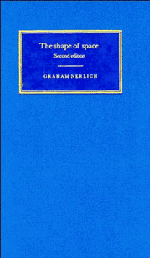Book contents
- Frontmatter
- Contents
- Preface
- Introduction
- 1 Space and spatial relations
- 2 Hands, knees and absolute space
- 3 Euclidean and other shapes
- 4 Geometrical structures in space and spacetime
- 5 Shapes and the imagination
- 6 The aims of conventionalism
- 7 Against conventionalism
- 8 Reichenbach's treatment of topology
- 9 Measuring space: fact or convention?
- 10 The relativity of motion
- Bibliography
- Index
9 - Measuring space: fact or convention?
Published online by Cambridge University Press: 04 December 2009
- Frontmatter
- Contents
- Preface
- Introduction
- 1 Space and spatial relations
- 2 Hands, knees and absolute space
- 3 Euclidean and other shapes
- 4 Geometrical structures in space and spacetime
- 5 Shapes and the imagination
- 6 The aims of conventionalism
- 7 Against conventionalism
- 8 Reichenbach's treatment of topology
- 9 Measuring space: fact or convention?
- 10 The relativity of motion
- Bibliography
- Index
Summary
A new picture of conventionalism
In chapter 7 I argued that there is no general justification for seeing parts of our theories in science or mathematics as mere conventions, empty of factual meaning. A general epistemological justification is always an attempt to bind theories to limitations in our powers of conception. At any rate, that is what I mean by ‘epistemology’. Conventionalism without epistemology binds the factual meaning of theories to limitations alleged to lie in the scope of things themselves. That is, things are supposed to be incapable of the degree of structure which the theory (taken at face value) gives them. Though conventionalism in general is implausible we might nevertheless find specific arguments which could apply in the case of certain of our theories. A case of this sort crops up now, when we turn to reflect on our theory of the sizes of things in space. It is said that the metric of space cannot be purely factual and must be partly conventional.
This idea has both popular and distinguished support. It is very easy to get people to agree, for example, that it is senseless (not factual) to say that everything – simply everything – doubled in size overnight, and also senseless to deny it (see §1.10). This is the thin end of a wedge that splits the idea of a factual metric wide open.
- Type
- Chapter
- Information
- The Shape of Space , pp. 195 - 218Publisher: Cambridge University PressPrint publication year: 1994



